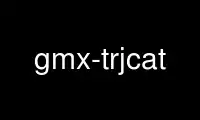
This is the command gmx-trjcat that can be run in the OnWorks free hosting provider using one of our multiple free online workstations such as Ubuntu Online, Fedora Online, Windows online emulator or MAC OS online emulator
PROGRAM:
NAME
gmx-trjcat - Concatenate trajectory files
SYNOPSIS
gmx trjcat [-f [<.xtc/.trr/...> [...]]] [-n [<.ndx>]] [-demux [<.xvg>]]
[-o [<.xtc/.trr/...> [...]]] [-tu <enum>] [-xvg <enum>]
[-b <time>] [-e <time>] [-dt <time>] [-[no]vel]
[-[no]settime] [-[no]sort] [-[no]keeplast]
[-[no]overwrite] [-[no]cat]
DESCRIPTION
gmx trjcat concatenates several input trajectory files in sorted order. In case of double
time frames the one in the later file is used. By specifying -settime you will be asked
for the start time of each file. The input files are taken from the command line, such
that a command like gmx trjcat -f *.trr -o fixed.trr should do the trick. Using -cat, you
can simply paste several files together without removal of frames with identical time
stamps.
One important option is inferred when the output file is amongst the input files. In that
case that particular file will be appended to which implies you do not need to store
double the amount of data. Obviously the file to append to has to be the one with lowest
starting time since one can only append at the end of a file.
If the -demux option is given, the N trajectories that are read, are written in another
order as specified in the .xvg file. The .xvg file should contain something like:
0 0 1 2 3 4 5
2 1 0 2 3 5 4
The first number is the time, and subsequent numbers point to trajectory indices. The
frames corresponding to the numbers present at the first line are collected into the
output trajectory. If the number of frames in the trajectory does not match that in the
.xvg file then the program tries to be smart. Beware.
OPTIONS
Options to specify input files:
-f [<.xtc/.trr/...> [...]] (traj.xtc)
Trajectory: xtc trr cpt gro g96 pdb tng
-n [<.ndx>] (index.ndx) (Optional)
Index file
-demux [<.xvg>] (remd.xvg) (Optional)
xvgr/xmgr file
Options to specify output files:
-o [<.xtc/.trr/...> [...]] (trajout.xtc)
Trajectory: xtc trr gro g96 pdb tng
Other options:
-tu <enum> (ps)
Unit for time values: fs, ps, ns, us, ms, s
-xvg <enum>
xvg plot formatting: xmgrace, xmgr, none
-b <time> (-1)
First time to use (ps)
-e <time> (-1)
Last time to use (ps)
-dt <time> (0)
Only write frame when t MOD dt = first time (ps)
-[no]vel (yes)
Read and write velocities if possible
-[no]settime (no)
Change starting time interactively
-[no]sort (yes)
Sort trajectory files (not frames)
-[no]keeplast (no)
Keep overlapping frames at end of trajectory
-[no]overwrite (no)
Overwrite overlapping frames during appending
-[no]cat (no)
Do not discard double time frames
Use gmx-trjcat online using onworks.net services
